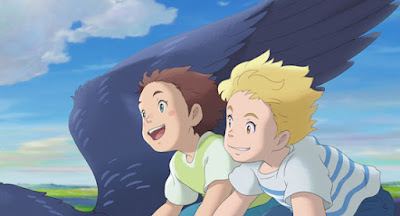Despite its often melancholy tone, director Yoshiyuki Momose’s wildly colorful film is a heartfelt valentine to children and their imaginary friends.
 |
| Amanda and her "imaginary friend," Rudger, enjoy wonderfully colorful adventures limited solely by what she dreams up. |
And, just as Studio Ghibli dipped into British children’s literature with 2010’s The Secret World of Arrietty — based on Mary Norton’s beloved 1952 novel, The Borrowers — Momose and screenwriter Yoshiaki Nishimura have adapted A.F. Harrold’s popular 2014 British children’s novel, with illustrations by Emily Gravett.
That said, Momose does his film no favors with a chaotic prologue likely to overwhelm viewers ... and perhaps even put them off. (Grit your teeth and hang on for five minutes, at which point things will make sense.)
Young Amanda (voiced in the American edition by Evie Kiszel) and her mother, Lizzie (Hayley Atwell) live above the Shuffleup Book Shop, a charming little store her parents established in an unspecified English country village. But Lizzie hasn’t been able to make ends meet since her husband’s recent death; job interviews haven’t been promising, and the shop is days from closing.
Her father’s absence explains Amanda’s creation of Rudger (Louie Rudge-Buchanan) — please, never “Roger” — an imaginary friend who proudly boasts that he was born “three months, three weeks and three days ago.” Thanks to an active imagination fueled by the contents of her marvelous attic bedroom — a retreat most of us would have hungered for, at a similar age — Amanda and Rudger share all manner of exciting, colorful and just-dangerous-enough-to-be-thrilling adventures.
Rudger is completely real to her, which — and this is the story’s core point — makes him real, although he can be seen only by Amanda. During their flamboyant exploits, all of them opulently realized by Momose and his talented animators, the two frequently chant a mantra:
“Whatever happens, never disappear ... protect each other ... and never cry.”
Their lively escapades are interrupted one day when the shop is visited by a sinister individual, who introduces himself as Mr. Bunting (Jeremy Swift). To Amanda’s astonishment, he can see Rudger; worse yet, Bunting is accompanied by a silent, sinister, black-garbed little girl imbued with the scariest qualities of Wednesday Addams. This phantasm also can see Rudger, and she — and Bunting — clearly are Big-Time Evil.
Lizzie, similarly spooked by Bunting — she can’t see his little companion — orders him out of the shop. But he’s destined to return; when that happens, tragedy unexpectedly separates Rudger from Amanda. He then begins to fade away, because — as he suddenly learns — most imaginary friends cease to exist, when children grow up to become disbelieving adults who have no time for “such nonsense.”
(At which point, viewers of a certain age will recognize that we’re solidly in the forlorn territory charted so well by Peter, Paul and Mary’s 1963 hit song, “Puff, the Magic Dragon.” So take a deep breath, because things are about to get rather grim,)
An omniscient cat named Jinzan (Kal Penn) — one red eye, one blue eye — helpfully directs Rudger to a huge, magical library that serves as a sanctuary for abandoned “Imaginaries.” They come in all shapes, sizes, species and pop-culture archetypes, although the place is sorta-kinda run by the very human Emily (Sky Katz).
When Rudger expresses surprise at these surroundings, Emily replies, “We’re imagined. Look around; this place is like an oasis. It’s made of imagination.”
But details get a little fuzzy, at this point in Momose’s film. The Imaginaries apparently are able to attach themselves to new children seeking such companions, which completely changes their form. But although Rudger goes through this process — with amusing results — he’s somehow able to ditch this new bond, without fading away, while trying to learn what happened to Amanda. This portion of the story doesn’t follow its own rules.
The relentlessly pursuing Mr. Bunting is a more consistent evil presence, and his actual intentions — once revealed — are downright horrifying.
Such perilous drama aside, Momose and Nishimura solidly establish their story’s key theme: that children often create imaginary friends in response to heartbreak, or a sense of something missing from their real-world lives. As such, such creations can become an essential comfort: clearly the case with Amanda ... and, in a nice touch, also true of Lizzie. If only she could remember what it was like, so many years ago...
The animation is consistently enchanting. The commonplace village cheerfulness, which surrounds the Shuffleup Book Shop, contrasts nicely with the flamboyantly dizzy fantasy-scapes fueled by Amanda’s imagination. The American voice talent is solid, and Atwell is particularly fine as a suddenly single mother trying hard not to yield to despair.
(That said, it’s always better to choose the Japanese voice cast, with English subtitles, and that option is available.)
The Imaginary won’t inhabit the Japanese animation pantheon occupied by classics such as Spirited Away and My Neighbor Totoro, but — during its best moments — Momose’s film certainly charms, and the premise is poignant and sweet.
No comments:
Post a Comment